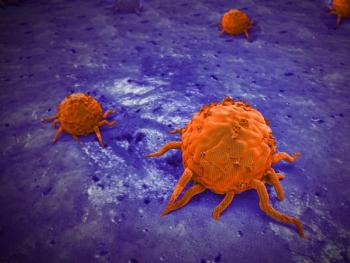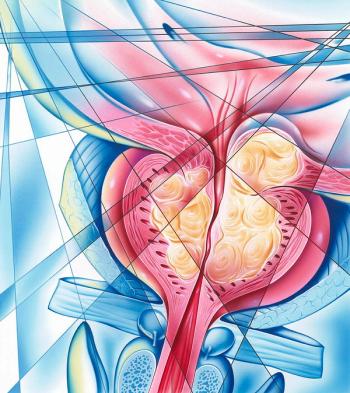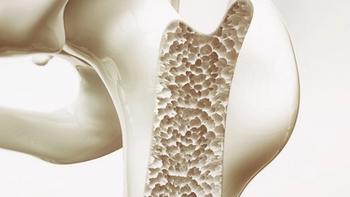
- ONCOLOGY Vol 16 No 9
- Volume 16
- Issue 9
Anemia in Cancer Patients: Significance, Epidemiology, and Current Therapy
Anemia in cancer patients is associated with a decline in energy levels, activity levels, and quality of life, and these variables improve when hemoglobin levels rise. Importantly, the impact of improved hemoglobin levels on response to chemotherapy, radiation therapy, and survival time is under study.
ABSTRACT: Anemia in cancer patients is associated with a decline in energy levels, activity levels, and quality of life, and these variables improve when hemoglobin levels rise. Importantly, the impact of improved hemoglobin levels on response to chemotherapy, radiation therapy, and survival time is under study. This line of research follows favorable preliminary data in clinical studies suggesting improved treatment outcomes with reversal of anemia. It is estimated that there are 10 million people in the United States with cancer. Of the 1.3 million cancer patients who are anemic with hemoglobin levels less than 12 g/dL, about 800,000 are receiving chemotherapy and 500,000 are not. The predominant treatable cause of anemia in these patients is a relative lack of erythropoietin; overall, only 20% of anemic cancer patients receive a trial of erythropoietic therapy. About one-fourth (26%) of patients whose hemoglobin is less than 12 g/dL and who are receiving chemotherapy for cancer are currently receiving erythropoietic therapy. A review of the patients in our oncology practice revealed that 37% were anemic (hemoglobin
Anemia in Cancer Patients
The malignancy itself, or chemotherapy or other therapies cancause decreased erythropoietin production or a reduced responsiveness in thebone marrow to erythropoietin.[15] The presence of an invasive malignant processtriggers an immune response with the release of various cytokines that, in turn,interfere with bone marrow function and shorten red cell survival. These areprobably the most common causes of cancer-related anemia. Other causes includeiron and vitamin B-12 deficiencies; additional vitamin and nutritionaldeficiencies; bleeding; bone marrow metastases; various types of hemolysis;infection; renal diseases; inflammatory disorders; a variety of hematologic diseases, including hemoglobinopathies; and endocrinopathies.
During the 1960s and 1970s, blood product transfusion supportwas a mainstay of therapy encouraged by the advances in transfusion medicine. Inthe last 20 years, increased recognition of the potential for transmission ofviral infections, as well as a limited blood supply, brought the need fortransfusion alternatives into the forefront.
Current Therapeutic Approaches
The advent of erythropoietic therapy over the past 10 yearshas allowed physicians to reduce the need for transfusions. The recognition thatanemia treatment can improve the quality of life for patients has revolutionizedthe field of oncology practice.
Other than red cell transfusions and/or erythropoietinadministration, specific therapies for anemia are only helpful in a few cases.One such new and interesting therapy is the use of the CD20 monoclonal antibodyrituximab (Rituxan) in the treatment of autoimmune hemolytic anemias, pure redcell aplasias, and cold agglutinin disease.[16-25] Iron replacement, vitaminB-12 replacement, and the identification of occult (usually gastrointestinal)bleeding are also important in some patients.
National Statistics:Cancer and Anemia
It is estimated that there will be 1.28 million new cases of cancer in the United States this year[26]; at any given time, there are approximately 10 million people with cancer. Of the 1.24 million people presently receiving cytotoxic chemotherapy (Tandem cancer audit 1/00-12/00 on file at Amgen), about 800,000 are anemic with hemoglobin levels less than 12 g/dL, and about 210,000 (26%) are currently receiving recombinant human erythropoietin (Epogen, Procrit). Interestingly, six tumor types account for more than 75% of all cases of chemotherapy-induced anemia (Figure 2), and seven tumor types account for 75% of erythropoietin use in this setting (Figure 3).
Another 475,000 cancer patients who are not receivingchemotherapy are anemic, but only 38,000 (8%) of these patients are receivingerythropoietin treatment. Worldwide, it is estimated that about 3 millionpatients are receiving erythropoietic therapy when all indications, including kidneydisease, are considered.[27]
The use of erythropoietin increases overall with lower levels of hemoglobin: 4% of cancer patients on chemotherapy with hemoglobin levels > 12.1 g/dL; 13% of patients with hemoglobin of 10.1 to 12.0 g/dL; and 34% of those with hemoglobin < 10.0 g/dL are receiving erythropoietic therapy (Figure 4).
Recent studies indicate that the largest improvements in patients’ quality of life are associated with a rise in hemoglobin at levels between 10 and 13 g/dL (Figure 5).[28] This information may be of value to physicians and patients, since it challenges the view that only hemoglobin levels < 10 g/dL need attention. Our personal clinical experience is that some patients clearly report major improvements of fatigue and physical function as their hemoglobin levels rise to > 11 g/dL. These patients often are unable to carry out their daily activities unless they receive ongoing erythropoietic therapy.
Estimates regarding the frequency of anemia in cancer patients need to include overall population growth projections (Figure 6), as well as data on the aging of the population. In many instances, cancer is becoming a chronic illness requiring chronic therapies often associated with anemia and its sequelae on the quality of life. It is estimated that the US population will approach 300 million by the year 2010, and that new cancer cases will approach 1.5 million per year by the same time. Because of a growing and aging population, it is anticipated that there will be a rather explosive growth of cancer thereafter, with 2.5 million new cases per year (involving patients 55 years and over) by the year 2020 (Figure 7). The lifetime probability of developing cancer presently is 43% for men and 38% for women.[26] These statistics indicate that cancer-associated anemia may become more prevalent in the future.
National estimates regarding the frequency of anemia by chemotherapy regimen are shown on Figure 8. The estimated US distribution of chemotherapy schedules of administration from 1996 through 2000 is shown in Figure 9.
Anemia in Cancer Chemotherapy Patients
Pacific Shores Experience
We retrospectively reviewed the records of 350 consecutive cancer patients who received chemotherapy between January 2000 and January 2002 at Pacific Shores Medical Group, a subspecialty oncology/hematology practice in Southern California. We evaluated only patients with a proven diagnosis of malignant disease who had complete blood count results available for a period of at least 12 weeks after initiating chemotherapy. Hemoglobin levels were reviewed at baseline (before a specific chemotherapy regimen was started) and for three consecutive 4-week periods (through week 12) after initiation of chemotherapy. We also studied tumor types, chemotherapy regimens, and their relationships with hemoglobin levels and erythropoietic therapy. Table 1 outlines the demographic characteristics of the patients and their tumor types.
Table 2 reports hemoglobin levels at the various time intervals and the percentage of patients who received erythropoietic therapy/transfusions of red cells. A total of 128 (37%) of patients were anemic (hemoglobin < 12.0 g/dL) at baseline. Of the 222 patients who were not anemic at baseline, 144 (65%) became anemic during the first 12 weeks of chemotherapy. Overall, 272 of the 350 patients (78%) were anemic at baseline or at some point during the 12 weeks of chemotherapy. Importantly, 163 out of the 350 patients (46%) had hemoglobin levels £ 11 g/dL at baseline or by 12 weeks of chemotherapy, and only 72 (20%) had a hemoglobin level of 10 g/dL or less at baseline or by 12 weeks of chemotherapy. In fact, excluding the 26 patients with hemoglobin levels of 10 g/dL or less at baseline, only 46 of 324 (13%) patients had hemoglobin levels decrease to £ 10 g/dL by 12 weeks of chemotherapy.
During the period of review, we generally followed local Medicare guidelines, which allowed erythropoietic therapy when hemoglobin levels were £ 10.8 g/dL in cancer patients receiving chemotherapy. Recent guidelines, which became active on July 15, 2002, allow erythropoietic therapy for patients with symptomatic cancer-associated anemia or chemotherapy-associated anemia when the hematocrit is < 36% or the hemoglobin is < 12 g/dL.[29] Of our patients on chemotherapy, 107 of 194 (55%) received erythropoietin during treatment, and 22 (6%) received packed red cells transfusions. The incidence of anemia by tumor type and the incidence of therapy with erythropoietin are reported in Table 3. The incidence of anemia by type of chemotherapy used and the use of erythropoietin in this setting are shown in Table 4.
Conclusions
The information presented indicates that anemia as acomplication of cancer or its therapy is very prevalent and likely to increasein occurrence. The importance of anemia as a factor affecting the quality oflife and physical functioning of patients is well established. Its effects oncognitive and psychologic outcomes, the efficacy of cancer therapy, and survivalduration are now being studied. Declines in erythropoietin are largelyresponsible for the anemia associated with cancer and chemotherapy, anderythropoietic therapy is often effective in reversing anemia and improvingphysical function and quality of life. While US estimates indicate that 25% ofanemic cancer patients (hemoglobin < 12 g/dL) on chemotherapy have receivederythropoietic therapy, in our practice 71% of anemic patients did. Ourstatistics may reflect recent increases in anemia awareness and treatment. Wealso attribute the difference to the fact that our nursing and physician staffsmay have an increased focus on quality-of-life issues like fatigue and treatmentof anemia.
Recent research indicates that the chronic anemia of cancerpatients not receiving chemotherapy is highly responsive to erythropoietictherapy as well; new guidelines by insurers are now including thisindication.[29,30] Barriers to the use of erythropoietic agents include cost andreimbursement issues, the need for frequent parenteral administration, limitedefficacy, and indication restrictions. The recognition that quality of life isimproved with increases of hemoglobin in the range of 10 to 13 g/dL isredefining the parameters that physicians, patients, and insurers look at indeciding when to intervene. The advent of the longer-acting erythropoietic agentdarbepoetin alfa (Aranesp)[31-35] provides relief from frequent injections, adevelopment that will be certainly welcomed by patients. More efficient andconvenient approaches to anemia prevention and therapy are now available withthe use of the long-acting erythropoietic agent darbepoetin.[36-42]
References:
1. Faulds D, Sorkin EM: Epoetin (recombinant humanerythropoietin): A review of its pharmacodynamic and pharmacokinetic propertiesand therapeutic potential in anaemia and the stimulation of erythropoiesis. Drugs38:863-899, 1989.
2. Glaspy J, Bukowski R, Steinberg D, et al: Impact oftherapy with epoetin alfa on clinical outcomes in patients with nonmyeloidmalignancies during cancer chemotherapy in community oncology practice. JClin Oncol 15:1218-1234, 1997.
3. Demetri GD, Kris M, Wade J, et al (for the Procrit StudyGroup): Quality-of-life benefit in chemotherapy patients treated with epoetinalfa is independent of disease response or tumor type: Results from aprospective community oncology study. J Clin Oncol 16:3412-3425, 1998.
4. Abels R: Erythropoietin for anaemia in cancer patients. EurJ Cancer 29A(suppl 2):S2-S8, 1993.
5. Glaus A, Muller S: Hemoglobin and fatigue in cancerpatients: Inseparable twins? Schweiz Med Wochenschr 130:471-477, 2000.
6. Groopman JE, Itri LM: Chemotherapy-induced anemia inadults: Incidence and treatment. J Natl Cancer Inst 91:1616-1634, 1999.
7. Demetri G: Anaemia and its functional consequences incancer patients: Current challenges in management and prospects for improvingtherapy. Br J Cancer 84(suppl 1):31-37, 2001.
8. Tchekmedyian NS, Hickman M, Siau, J, et al: Treatment ofCancer Anorexia With Megestrol Acetate: Impact on Quality of Life. Oncology(Huntingt)4:185-192, 1990.
9.Kumar P: Impact of anemia in patients with head and neckcancer. Oncologist 5(suppl 2):13-18, 2000.
10. Smaniotto D, Luzi S, Morganti A: Prognostic significanceof anemia and role of erythropoietin in radiation therapy. Tumori86:17-23, 2000.
11. Pirker R, Vansteenkiste J, Gateley J, et al: A phase 3,double-blind, placebo-controlled, randomized study of novel erythropoiesisstimulating protein (NESP) in patients undergoing platinum treatment for lungcancer (abstract 1572). Proc Am Soc Clin Oncol 20:394a , 2001.
12. MacRae R, Choy H, Shyr Y, et al: Significance ofhemoglobin changes during chemoradiotherapy in non-small cell lung cancer (NSCLC):An analysis of three sequential trials (abstract 1336). Proc Am Soc ClinOncol 20:335a, 2001.
13. Phan T, Crane C, Mendoza T, et al: Low hemoglobin levelsafter preoperative chemoradiation for locally advanced rectal cancer areassociated with a worse survival (abstract 596). Proc Am Soc Clin Oncol20:150a, 2001.
14. Smith RE, Jaiyesimi IA, Meza LA, et al: Novelerythropoiesis stimulating protein (NESP) for the treatment of anaemia ofchronic disease associated with cancer. B J Cancer 84(suppl 1):24-30,2001.
15. Glaser C, Millesi W, Gössweiner, T et al: R-HuErythropoetinsupply increased efficacy of neoadjuvant radiochemotherapy in patients with oralsquamous cell carcinoma (abstract 1532). Proc Am Soc Clin Oncol 17: 397a,1998.
16. Ghazal H: Successful treatment of pure red cell aplasiawith rituximab in patients with chronic lymphocytic leukemia. Blood 99:1092-1094,2002.
17. Zaja F, Russo D, Fuga G, et al: Rituximab in a case ofcold agglutinin disease. Br J Haematol 115:232-233, 2001.
18. Berentsen S, Tjonnfjord GE, Brudevold R, et al:Favourable response to therapy with the anti-CD20 monoclonal antibody rituximabin primary chronic cold agglutinin disease. Br J Haematol 115:79-83,2001.
19. Seeliger S, Baumann M, Mohr M, et al: Autologousperipheral blood stem cell transplantation and anti-B-cell directedimmunotherapy for refractory auto-immune haemolytic anaemia. Eur J Pediatr160:492-496, 2001.
20. Ahrens N, Kingreen D, Seltsaam A, et al: Treatment ofrefractory autoimmune haemolytic anaemia with anti-CD20 (rituximab). Br JHaematol 114:244-245, 2001.
21. Zecca M, De Stefano P, Nobili B, et al: Anti-CD20monoclonal antibody for the treatment of severe, immune-mediated, pure red cellaplasia and hemolytic anemia. Blood 97:3995-3997, 2001.
22. Sparling TG, Andricevic M, Wass H: Remission of coldhemagglutinin disease induced by rituximab therapy. CMAJ 164:1405-1406,2001.
23. Bauduer F: Rituximab: A very efficient therapy in coldagglutinins and refractory autoimmune haemolytic anaemia associated withCD20-positive, low-grade non-Hodgkin’s lymphoma. Br J Haematol112:1085-1086, 2001.
24. Seipelt G, Bohme A, Koschmieder S, et al: Effectivetreatment with rituximab in a patient with refractory prolymphocytoidtransformed B-chronic lymphocytic leukemia and Evans syndrome. Ann Hematol80:170-173, 2001.
25. Layios N, van den Neste E, Jost E, et al: Remission ofsevere cold agglutinin disease after rituximab therapy. Leukemia15:187-188, 2001.
26. Jemal A, Thomas A, Murray T, et al: Cancer Statistics,2002. CA Cancer J Clin 52:23-47, 2002.
27. Bunn HF: Drug-induced autoimmune red-cell aplasia. NEngl J Med 346:522-523, 2002.
28. Crawford J, Cella D, Cleeland CS, et al: Relationshipbetween changes in hemoglobin level and quality of life during chemotherapy inanemic cancer patients receiving epoetin alfa therapy. Cancer 95:888-895,2002.
29. NHIC Medicare Final Local Medical Review Policy. Coverageof Injection Epoetin Alfa (Procrit, Epogen, Eprex, erythropoietin, EPO) for theTreatment of Anemia Unrelated to Dialysis Therapy. LMRPs 02-2, pp 50-59,June 2002.
30. Smith RE, Meza L, Tchekmedyian S, et al: Open-label,phase I/II dose escalation study of NESP in patients with chronic anemia ofcancer (abstract 1574). Proc Am Soc Clin Oncol 20:394a, 2001.
31. Smith RE, Tchekmedyian S, Richards D, et al: Darbepoetinalfa effectively alleviates anemia in patients with chronic anemia of cancer:Efficacy and pharmacokinetic results of a dose-escalation study (abstract 1465).Proc Am Soc Clin Oncol, 21:367a, 2002.
32. Glaspy JA, Jaswant J, Justice G: Optimizing themanagement of anemia in patients with cancer: A randomized, active-controlledstudy investigating the dosing of darbepoetin alfa (abstract 1446). Proc AmSoc Clin Oncol, 21:362a, 2002.
33. Kallich J, Erder H, Glaspy JA, et al: Darbepoetin alfahas higher observed improvements in fatigue and physical well-being than epoetinalfa (abstract 1466). Proc Am Soc Clin Oncol 21:367a, 2002.
34. Heatherington A, Schuller J, Dittrich C: Intravenous (IV)administration of darbepoetin alfa to patients with nonmyeloid malignanciesreceiving multicycle chemotherapy: Pharmacokinetic profiles (abstract 2844). ProcAm Soc Clin Oncol 21:256b, 2002.
35. Kotasek D, Albertsson M, Mackey J: Randomized,double-blind, placebo-controlled, dose-finding study of darbepoetin alfaadministered once every 3 (q3w) or 4 (q4w) weeks in patients with solid tumors(abstract 1421). Proc Am Soc Clin Oncol, 21:356a, 2002.
36. Macdougall IC, Gray SJ, Elston O, et al: Pharmacokineticsof novel erythropoiesis stimulating protein compared with epoetin alfa indialysis patients. J Am Soc Nephrol 10:2392-2395, 1999.
37. Vanrenterghem Y, Barany P, Mann J: Novel erythropoiesisstimulating protein (NESP) maintains hemoglobin in ESRD patients whenadministered once weekly or once every other week (abstract A1365). J Am SocNephrol 10:270A, 1999.
38. Glaspy J, Colowick AB, Heatherington A: Novelerythropoiesis stimulating protein (NESP) exhibits a prolonged serum half-lifein oncology patients (abstract 210). J Am Soc Nephrol 19:54a, 2000.
39. Glaspy J, Jadeja JS, Justice G, et al: A dose-finding andsafety study of novel erythropoiesis stimulating protein (NESP) for thetreatment of anaemia in patients receiving multicycle chemotherapy. Br JCancer 84(suppl 1):17-23, 2001.
40. Smith RE Jr, Jaiyesimi IA, Meza LA, et al: Novelerythropoiesis stimulating protein (NESP) for the treatment of anaemia ofchronic disease associated with cancer. Br J Cancer 84(suppl 1):24-30,2001.
41. Kotasek D, Berg R, Poulsen E, et al: Randomized,double-blind, placebo controlled, phase I/II dose finding study of Aranespadministered once every three weeks in solid tumor patients (abstract 1268).Blood 96:294a, 2000.
42. Heatherington A, Rovetti R, Kotasek D, et al:Predictability of pharmacokinetic properties of NESP administered once every 3weeks in patients with nonmyeloid malignancies receiving cyclic chemotherapy(abstract 471). Proc Am Soc Clin Oncol 20:119a, 2001.
Articles in this issue
about 23 years ago
The Molecular Basis of Cancer, 2nd Editionabout 23 years ago
Management of Anemia in Patients With Cancerabout 23 years ago
Commonly Used Quality of Life and Symptom Measurement Scalesabout 23 years ago
Iron and the Anemia of Chronic Diseaseabout 23 years ago
Diagnosis and Management of Aplastic Anemia and Myelodysplastic Syndromeabout 23 years ago
Recombinant Human Erythropoietin in Cancer-Related Anemiaabout 23 years ago
When Is it Justified to Treat Symptoms? Measuring Symptom BurdenNewsletter
Stay up to date on recent advances in the multidisciplinary approach to cancer.


















































































